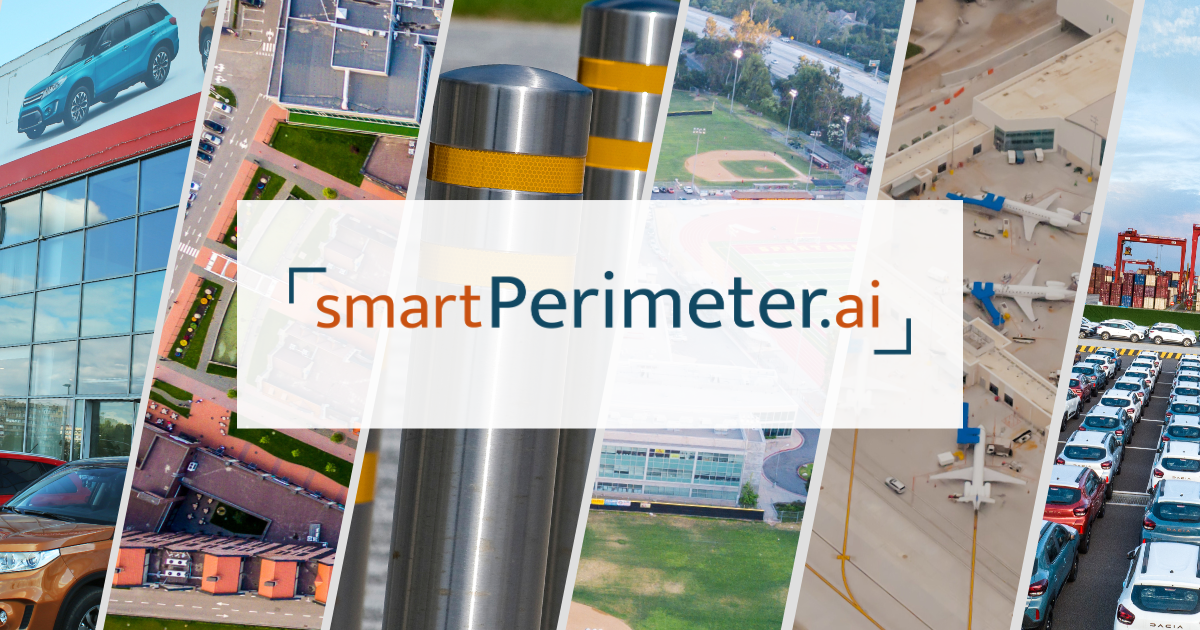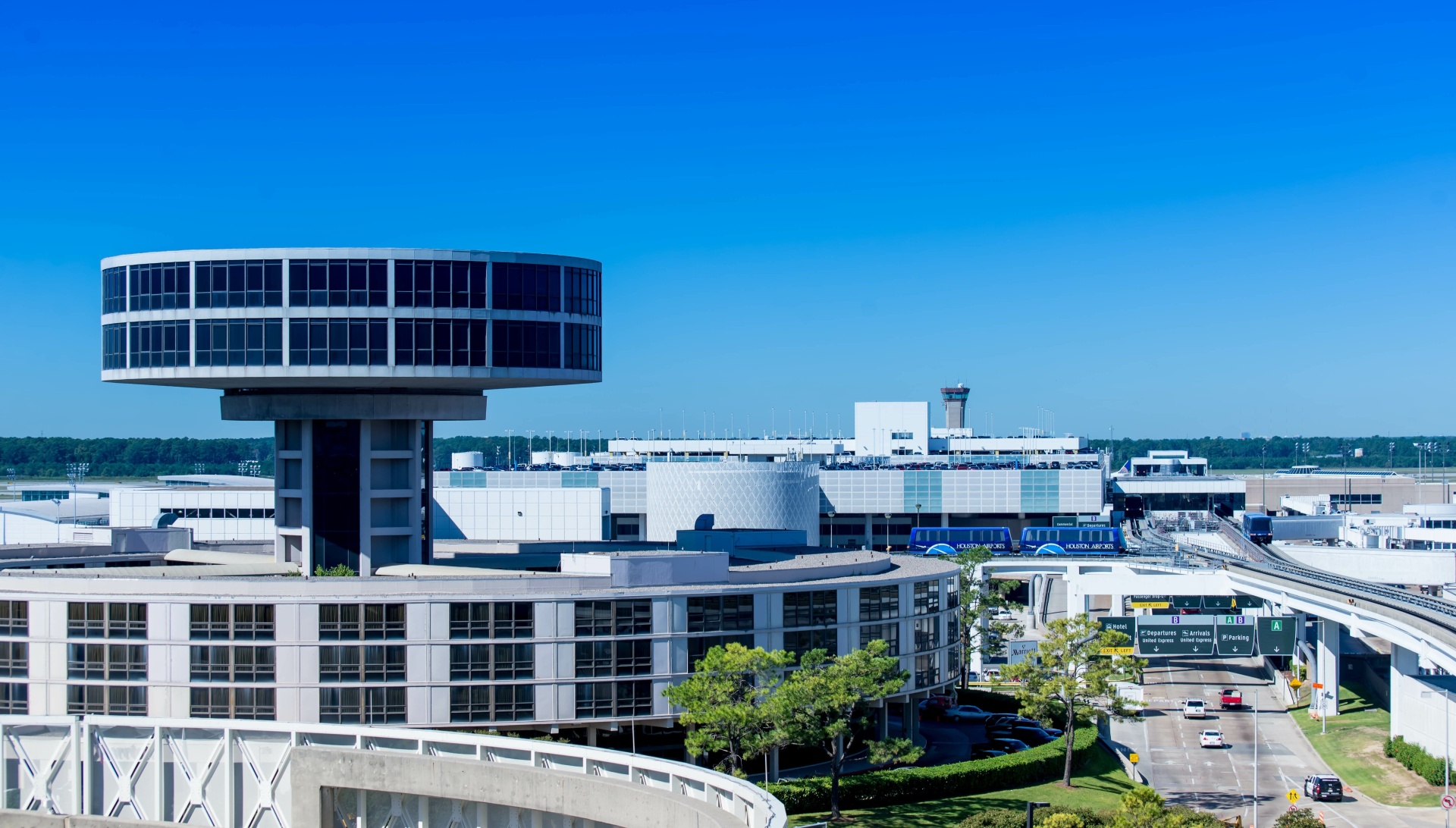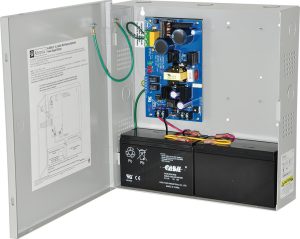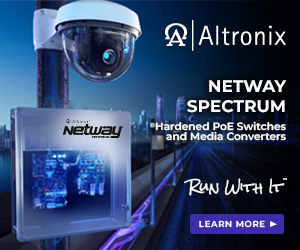
June 2025 Issue

A MESSAGE FROM THE PUBLISHER
“It’s not just a fence, it’s a living system.”
Cathy Lanier, CSO, NFL
Cathy’s beautiful insight truly captures our June Special Report on Ports- Sea, Land & Air. Yes, there is a legal perimeter and a fence line. The perimeter is virtual and continuously adjusted by the site’s threat matrix. Ports present one of the most complex risk mitigation challenges. Editor, Heather Martin’s Special Report explores the solutions being successfully employed for critical perimeter solutions in this important sector.
Our June Case Study explores Houston’s George Bush Intercontinental Airport (IAH) Terminal D-West Pier expansion and their reliance on Altronix. All ports, including IAH, require reliable power for their perimeter security systems and Altronix provides it.
AI is an effective and efficient solution for security and the growing focus on pedestrian safety. Our feature article: How Artificial Intelligence Is Reinventing Perimeter Security for High-Value Sites focuses on leading solutions and successful use cases are presented.
Sensors are cheap, reliable, sometimes noisy, and installed at a record pace. And why not? Their ability to detect, communicate and alert with increasingly positive price/performance is attractive. This month’s Product Focus on Sensors provides a comprehensive resource for you.
We are always learning! In this issue: 5 Questions for Smart People learns from Skip Burnham about Dortronics Systems’ Mantraps and Sally Ports, which are vital for physical security access control. They were once only used in the highest sensitivity applications, but are becoming mainstream today. Have you walked out of an airport lately? Learn with us by reading Skip’s interview.
As we welcome you to our second issue, we thank you for the great response to smartPerimeter.ai with nearly 50,000 subscribers receiving this issue. Be sure to follow #smartPerimeter.ai on LinkedIn.
We hope you both enjoy and learn from this month’s issue. Please let us know at info@smartPerimeter.ai
Mark McCourt
SMART PERIMETER JUNE SPECIAL REPORT
Securing the Critical Perimeter: Advanced Technologies Transforming Land, Sea & Air Port Security
How integrated systems are reshaping port perimeter defense

Executive Summary
Recent incidents reveal a troubling pattern: the same perimeter security vulnerabilities plague airports, seaports, and critical infrastructure land ports worldwide. In September of 2024, Caribbean Port Services announced that it was cutting off land access to the main seaport in Port-au-Prince so that the Haitian police and the army could restore security in the area and resume delivery operations. The shutdown occurred after a slew of incidents including a crane operator being shot and two container ship crew members being kidnapped by gangs. And in April 2025, a vehicle rammed into the entrance at Manila’s Ninoy Aquino International Airport terminal one, killing a child and injuring several others—highlighting the urgent need to address land-based threats.
The breakthrough insight driving modern perimeter protection is that air, land, and sea ports, despite their operational differences, share core security challenges. Facial recognition systems that eliminate badge vulnerabilities at airports can be just as effective at maritime ports. Security entrances, electric fences and vehicle barriers that prevent breaches at airports offer the same protection for maritime and land-based terminals. This convergence enables port authorities to standardize and scale technologies across all facility types, reducing the need for separate, domain-specific solutions.
Integrated technologies are delivering measurable results across domains. At Phoenix Sky Harbor International Airport, advanced systems helped prevent vehicle breaches and maintain uninterrupted operations, protecting an estimated $100 million in annual revenue. Globally, the perimeter security market reached $79.8 billion in 2023, with AI-driven solutions reducing false alarms by up to 60%, according to the Perimeter Security Market Size Report.
Security leaders increasingly rely on Return on Security Investment (ROSI) metrics to validate upgrades that reduce breach costs, support compliance, and improve operational continuity. Evolving threats across ports are driving leaders to invest in smarter, more connected protection strategies.
Converging Threats Across Ports
Airports, seaports, and land-based ports today face unprecedented perimeter security and safety challenges, driven by emerging challenges, operational strain, and aging infrastructure. Recent incidents highlight the vulnerability of these vital facilities to both deliberate attacks and unintentional breaches.
Security Breach Statistics:
- The Transportation Security Administration reported over 300 cases of individuals bypassing airport security between March 2023 and April 2024.
- Vehicle ramming incidents at major facilities, including Cologne-Bonn Airport and Seattle-Tacoma International Airport, have resulted in injuries and operational shutdowns.
- GPS interference is affecting commercial operations, with carriers forced to suspend routes due to signal jamming.
Common Security Gaps Across Port Operations:
- Air Operations: Post-pandemic staffing shortages create security gaps at airports worldwide
- Sea Operations: Port facilities face increasing pressure from cargo volume growth and evolving threat vectors.
- Land Operations: Land-based ports struggle with aging security systems and compliance requirements.
Operational Pressures:
- Security delays directly impact productivity and customer experience across all domains.
- Budget constraints require solutions that deliver measurable ROI.
- Regulatory compliance demands increasingly sophisticated access control measures.
These converging threats demand a new generation of perimeter solutions—ones that deliver stronger protection, greater efficiency, and a measurable return on investment (ROI) across all domains.

Technology in Action: Perimeter Solutions Driving Safer Ports
As port facilities confront increasingly complex perimeter challenges, five categories of technology are proving essential. From physical barriers to intelligent access control, these solutions share one trait: they prevent disruptions before they start, while preserving operational flow.
1. Intelligent Key Control Closes Access Gaps
Securing access to physical keys, tools, and ground support equipment is a high-stakes challenge across ports. From airside gates to restricted storage areas, a single lost or misused key can compromise perimeter integrity.
Modern key control strategies replace outdated key rings and paper logs with centralized systems that log access, enforce return protocols, and trigger alerts for missing or overdue items. These platforms reduce insider risk, enhance compliance, and enable faster response, minimizing downtime and preventing unauthorized access across the perimeter.
Core perimeter functions supported by key control systems:
- Real-time traceability: Log and monitor access to perimeter-critical assets.
- Two-step access control: Enforce PIN or badge authentication for added security.
- Automated alerts: Flag late returns, tampering, or unauthorized attempts.
- System coordination: Link with access control to trigger movement restrictions.
- Zone-level protection: Prevent vehicle or tool use unless keys are returned.
Smart key control helps close physical gaps and reinforce perimeter security from the inside out.
2. Keeping Essential Systems Powered and Protected
Perimeter systems from surveillance to emergency response, depend on uninterrupted power. In large facilities like airports, distributed power hubs support hundreds of endpoints, ensuring uptime during both routine operations and emergencies. Beyond keeping devices online, modern power systems enable visibility, prevent access failures, and ensure that emergency protocols function when seconds count. Even brief outages can lead to blind spots, compliance failures, or a delayed response.
How power systems drive operational efficiency:
- Uptime for all systems: Ensure security hardware remains operational during outages, maintenance, or extreme weather.
- Environmental durability: Power gear must perform in harsh outdoor, marine, or industrial conditions.
- Redundant protection: Built-in battery backup and surge suppression protect against failure or sabotage.
- Flexible form factors: Rack, wall, and cabinet-mounted systems fit into constrained or distributed infrastructure.
- Expandable design: Scale with growing coverage from expanding terminals to ports.
Power infrastructure is often invisible, but it’s foundational. Without it, there is no access control, no video, no safety alerts. Investing in hardened, intelligent systems ensures that perimeter functions stay active, secure, and resilient.
3. Vehicle Barriers and Physical Deterrents: Controlling Access, Preventing Harm
Vehicle access is one of the most exploited and overlooked vulnerabilities at ports. Whether it’s unauthorized tailgating, accidental entry into restricted zones, or intentional ramming attacks, unmanaged vehicular flow presents serious risks to perimeter safety and integrity.
Crash-rated barriers, bollards, and deployable vehicle barricades provide a physical layer of protection that complements electronic access systems and other solutions. Positioned at cargo entry gates, terminal drop-off zones, tarmac roads, or maintenance yards, these deterrents restrict movement where it matters most, while allowing safe passage for authorized personnel and deliveries.
Crash-rated barriers and deployable deterrents offer fast response and scalable control. In dynamic port environments, modern systems integrate with surveillance and scheduling tools to adapt instantly, reinforcing security while enabling smooth throughput for authorized vehicles.
Core functions of barrier systems:
- Prevent ramming and breach attempts: Protect people and assets from hostile vehicle attacks.
- Support controlled throughput: Manage flow of commercial vehicles, staff shuttles, and emergency responders.
- Segment secure zones: Physically separate public-facing areas from sensitive operations like customs, baggage, or cargo handling.
- Enable safe pedestrian movement: Reduce risk of accidents in mixed-use environments.
- Respond to alerts or lockdowns: Integrate with emergency systems to trigger automatic closure or lockdown in real time.
Effective protection isn’t just about detecting threats; it’s about stopping them. Vehicle barriers serve as a frontline defense, turning passive access points into actively managed control zones that protect infrastructure, operations, and lives.
4. Biometric Access: Securing Entry with Facial Recognition
Facial recognition offers a secure, touchless alternative to badges or PINs—credentials increasingly vulnerable to loss, misuse, and social engineering. Designed for challenging environments, these modern systems operate reliably in rain, glare, and low light. In one airport deployment, facial recognition eliminated badge-based chokepoints and cut onboarding time, delivering measurable gains in both security and operational efficiency.
Facial recognition supports safer access through:
- Real-time identity verification across secure zones
- Elimination of shared or misplaced physical credentials
- Mobile enrollment tools for high-turnover staff
- Touchless authentication that speeds up throughput
- Seamless integration with existing access platforms
- Data protection through privacy-first system design
Biometric systems continue to prove their value in high-security environments where operational efficiency and secure access must go hand in hand.
5. Secured Entry Systems: Controlling Critical Access Points
While fences and barriers define the outer edge, true perimeter security depends on managing internal movement. Secured vestibules, full-height portals, and automated entry systems defend high-risk areas like customs zones, cargo bays, or operations centers from tailgating, piggybacking, and unauthorized access.
Using intelligent sensors and real-time integration with access platforms, these secured entry systems detect multiple occupancy attempts, trigger lockdowns, and enable automated auditing. Their design also accommodates operational needs—supporting equipment transport, ensuring accessibility, and maintaining throughput during peak activity.
Benefits of secured entry systems include:
- Prevention of tailgating, piggybacking, and credential misuse
- Controlled, auditable access to secure areas
- Seamless connectivity with access systems and lockdown protocols
- Reduced reliance on security personnel
- Configurations that support luggage, gear, or accessibility requirements
As port environments grow more complex, secured entrances create a necessary checkpoint between public-facing zones and the critical infrastructure that keeps operations moving safely.
Evolving Port Protection: Safety, Security, and Scalability
Across land, sea, and air, critical infrastructure leaders are redefining what it means to secure the perimeter. It’s no longer just a fence line, it’s a layered, dynamic ecosystem that integrates identity, access, deterrence, and power resilience.
What unifies today’s most effective solutions isn’t just security, it’s operational strength. From intelligent key management to biometric verification, crash-rated barriers, and robust power infrastructure, modern systems safeguard people and assets while ensuring uptime, compliance, and ROI.
As threats evolve and complexity increases, the path forward lies in scalable, adaptable technologies that can meet needs across domains and facility types. Whether protecting terminals, shipping yards, or inland control zones, the next generation of perimeter strategy is clear: unified, intelligent, and built to endure.
SPOTLIGHT
Houston Airport Expansion Powered By Altronix
Future-Ready Solutions

Houston’s George Bush Intercontinental Airport (IAH) has entered a new era of international travel with the completion of the Terminal D-West Pier expansion. Unveiled in October 2024, this milestone marks a key phase of the IAH Terminal Redevelopment Program (ITRP), the single largest capital improvement project ever developed by Houston Airports.
The $1.46 billion initiative included a complete refresh of the existing Terminal D, the addition of the 160,000-square-foot D-West Pier, and the upcoming International Central Processor, set to be completed by summer 2025. With six new gates capable of accommodating wide-body aircraft and space for up to 10 narrow-body planes, the expansion enhances IAH’s international travel capabilities to meet growing passenger demand.
The project goes beyond functional upgrades, incorporating local charm with eight Houston-inspired art installations. These additions earned the airport the prestigious Skytrax award for Best Airport Art & Entertainment Program. The terminal also introduces 16 new retail and dining options, blending local favorites like The Annie and The Kitchen with national staples such as Einstein Bros. Bagels and Popeyes. Houston Mayor John Whitmire captured the spirit of the transformation, stating, “The newly expanded international terminal enhances Houston’s reputation as a world-class city and provides a boost to our economy, supporting jobs and attracting more visitors from around the globe.”
A Collaborative Effort Across Teams
Under the guidance of Fentress Architects, the Terminal D-West Pier project was a collaborative effort involving numerous teams, including Burns Engineering and PGA Engineers. Burns played a key role, overseeing technology, fire alarms, and special systems such as displays, while security and Distributed Antenna Systems (DAT) were subcontracted to specialized firms.
“This project involved two years of construction, incorporating both temporary structures designed for a 20-year lifespan and permanent buildings built to last 50 years,” noted a security specialist involved in the project. “A forward-thinking approach was essential to ensure that IT and security systems could accommodate future growth and evolving needs.”
Altronix: A Standard of Reliability and Scalability
At Houston Airport, one of the busiest travel hubs in the country, Altronix solutions play a vital role in ensuring smooth and secure operations. As an approved vendor for Houston Airport System (HAS) for over a decade, Altronix has been trusted for its reliability and scalability across all three Houston airports: George Bush Intercontinental (IAH), Hobby, and Ellington Field.
“The reason we use Altronix products over others is their reliability,” said Trent Bishop, IT Project Manager for Houston Airport System. “They’ve been a standard with HAS for well over 13 years, long before I joined the team.”
Intermediate Distribution Frames (IDFs) are critical network hubs connecting devices like cameras and access controls to the central system. In high-traffic environments like airports, where even brief downtime can disrupt operations and compromise safety, reliable power is essential.
Strategically installing Altronix power supplies within these hubs ensures consistent, stable power delivery to vital systems such as surveillance, access control, and data management. With a proven track record in demanding environments, Altronix products maintain operational continuity and security.
Technology Focus: Altronix Solutions at Terminal D “Houston Airport relies on Altronix solutions for the unwavering reliability they demand, while our scalable architecture ensures seamless growth alongside their future expansion,” Ronnie Pennington, Director of Sales for the Americas for Altronix. “Engineered specifically for high-demand environments, our products are the perfect fit for mission-critical infrastructure, exemplified by their successful deployment in Terminal D.”
Altronix provided tailored solutions to address the complex demands of modern airport operations, ensuring reliable power distribution and built-in safeguards to minimize downtime. With enhanced scalability and flexibility, these systems align seamlessly with HAS’s innovative approach to future-proofing its infrastructure, meeting the airport’s growing security needs.
The project incorporated over 400 cameras and 250 access-controlled security doors. To meet these rigorous requirements, PGA specified the Altronix Maximal3RD Access Power Controller for electronic locks. Its rack-mount design allows co-location with access control field panels, streamlining installation and maintenance. Additionally, the unit’s 16 PTC-protected outlets (auto-resettable) improve reliability by eliminating the need for manual reset of fuses or circuit breakers, ensuring secure door operation in this high-security environment.
 The Altronix AL300ULX Series wall-mount power supply was also selected for powering magnetic door holders, providing the flexibility and dependability required to support seamless operation in high-traffic areas. The Altronix Maximal3RD Access Power Controller and AL300ULX Power Supply Charger work together to deliver a centralized, dependable power solution. The AL300ULX is a regulated 12VDC or 24VDC power supply/charger, delivering up to 2.5A of continuous power with built-in battery backup to maintain uninterrupted operation during outages. Power is distributed through the Maximal3RD, which features multiple fused or PTC-protected outputs, LED indicators for easier troubleshooting, and a fire alarm interface for emergency shutdowns. Together, these components efficiently power electric locks, access control panels, and other critical devices, enhancing system reliability and performance.
The Altronix AL300ULX Series wall-mount power supply was also selected for powering magnetic door holders, providing the flexibility and dependability required to support seamless operation in high-traffic areas. The Altronix Maximal3RD Access Power Controller and AL300ULX Power Supply Charger work together to deliver a centralized, dependable power solution. The AL300ULX is a regulated 12VDC or 24VDC power supply/charger, delivering up to 2.5A of continuous power with built-in battery backup to maintain uninterrupted operation during outages. Power is distributed through the Maximal3RD, which features multiple fused or PTC-protected outputs, LED indicators for easier troubleshooting, and a fire alarm interface for emergency shutdowns. Together, these components efficiently power electric locks, access control panels, and other critical devices, enhancing system reliability and performance.
“The Maximal3RD was chosen for its rack-mount design, which optimizes space and simplifies integration with access control panels,” said Ronnie Pennington. “Its PTC-protected outlets further enhance system reliability, reducing downtime and eliminating the need for manual resets.”
Navigating Challenges in a Live Airport Environment
The project wasn’t without its challenges. Construction crews had to work around active airport operations, particularly for the 11 existing gates, which remained functional during renovations.
“All work had to be scheduled at night or during periods when flights wouldn’t be impacted,” explained a security expert familiar with the project. “This required adjustments for some contractor teams unaccustomed to night work, but the team adapted to ensure minimal disruption for passengers and to keep the project on schedule.”
Future-Proofing Houston’s Global Gateway
The Terminal D expansion exemplifies Houston Airports dedication to addressing today’s operational demands while anticipating tomorrow’s challenges. By implementing scalable, high-performance solutions like Altronix power systems and incorporating IT spaces designed for 25% future capacity, the project positions IAH to accommodate decades of growth and innovation.
As Bishop noted, reliability is paramount. Altronix’s enduring partnership with HAS shows its ability to deliver trusted performance consistently in mission-critical environments.
The Terminal D expansion is more than an infrastructure upgrade—it’s a blueprint for sustainable growth, reflecting the power of collaboration, forward-looking technology, and strategic foresight.
SmartPerimeter Interview: Magnasphere
Listen in as smartPerimeter publisher Mark McCourt interviews Mike Keegan, VP of Security for Magnasphere.
AI AT THE EDGE
AI is Reinventing Perimeter Security for High-Value Sites

By smartPerimeter.ai – June 2025
From hyperscale data centers to multimodal freight terminals, from smart city infrastructure to sprawling corporate campuses, businesses responsible for critical infrastructure are facing escalating threats. As traditional perimeter defenses strain to keep up with the scale, speed, and sophistication of modern intrusions, a new force has entered the arena: Artificial Intelligence.
AI-driven physical security tools are no longer a novelty—they’re a necessity. Forward-looking organizations are embedding intelligent systems at the edge of their operations to detect, analyze, and respond to threats in real-time—often without human intervention.
We review the latest AI-centric solutions and the use cases that mitigate risk for security organizations. Further, we explore how AI is advancing pedestrian safety.
Eliminate False Alarms: AI Enhanced Video Alarm Verification
Evolon’s Proactive Video Monitoring helps stop crime before it happens by combining industry-best AI threat detection, automation, and live human response to protect businesses after hours. With superior accuracy and long-range detection, Evolon gives end-users unmatched situational awareness, delivering true peace of mind that threats won’t slip through the cracks.
With a focus on automation, simplicity, and white-glove support, Evolon helps integrators grow their business while delivering next-generation protection to customers who need it most.
Use Case
Video surveillance AI software uses machine learning algorithms trained on vast datasets. Active training ensures the AI can distinguish between usual scenes and security threats. AI software becomes more precise by learning and adapting over time. Increasing threat accuracy leads to further decreasing false alarms. Security operators receive only relevant and actionable alerts, saving time and resources.
Real-Time Eyes: AI-Enhanced Video Analytics
AI-enabled video analytics is one of the most widely adopted tools in the perimeter security playbook. Solutions from companies like Motorola Solutions (Avigilon), BriefCam, and Rhombus are capable of not just recording, but interpreting visual feeds—flagging loitering, tailgating, motion anomalies, or unauthorized vehicle movement with precision. Deep learning models, trained on massive datasets, allow cameras to distinguish between a stray dog and a human intruder.
Use Case
At hyperscale data centers, AI video systems track human movement around secure zones, integrate with access control systems, and can auto-escalate alerts when a pattern of suspicious activity is detected—like repeated slow driving along the perimeter.
Sensor Fusion and AI Decision Engines
Modern perimeter systems now employ sensor fusion, combining radar, lidar, thermal, acoustic, and vibration sensors—all interpreted by AI engines that eliminate false positives and generate actionable alerts. Vendors like Dedrone, ZeroEyes, and Magos Systems are integrating AI to correlate disparate sensor data, distinguish between threat types, and automate response workflows.
Use Case
Intermodal terminals are chaotic environments with heavy equipment, workers, and constant vehicle flow. AI-powered sensor fusion systems can filter out “normal” movement and immediately isolate perimeter breaches—like a climber scaling a fence or an unattended drone flying over restricted zones.
Autonomous Patrols and AI-Driven Robotics
Autonomous robots and drones equipped with AI are becoming a fixture in perimeter security—especially where coverage demands exceed human capacity. Vendors such as Asylon, SMP Robotics, and Knightscope are deploying security robots and aerial drones with AI navigation, object recognition, and audio deterrent capabilities.
Use Case
On corporate campuses, these AI-driven patrol units scan for after-hours activity, verify badge access at perimeter gates, and deter intruders with real-time alerts or audio engagement—freeing up human guards for higher-value tasks.
AI’s Role in Compliance and Incident Forensics
Beyond detection and deterrence, AI is streamlining compliance and incident response. Audit trails are generated automatically. Incident metadata—what happened, when, and where—is categorized and searchable. Tools from Openpath, Evolv Technology, and Axis Communications integrate these features, ensuring businesses meet regulatory standards without drowning in manual logs.
Use Case
A Fortune 500 company’s security operations center (SOC) can use AI to quickly review a perimeter breach incident by querying “unauthorized entry after 10 PM near loading docks”—saving hours of manual video review.
FEATURED CONTENT
Pedestrian Safety Needs an AI-Powered Mindset…
Before Tragedy Strikes.

More than 100 vehicles drive into commercial buildings every day in the U.S., resulting in approximately 16,000 injuries and more than 2,600 deaths every year—nearly a third involving pedestrians in restaurants, storefronts, or retail settings. (Sources and more information at reliance-foundry.com and storefrontsafety.org) It’s a problem as pervasive in suburbs as it is in big cities.
The survival game? It starts with artificial intelligence—deployed through smarter cars, smarter roads, and smarter city planning.
- AI‑Powered Pre‑Crash Detection in Vehicles
Advanced Driver Assistance Systems (ADAS) like Volvo’s pedestrian recognition and automatic braking use cameras, radar, and now AI to spot humans—even at night—and slam the brakes before impact. Studies suggest these systems could cut pedestrian fatalities by up to 50%.
- Citywide Real‑Time Incident Alerts
Cities like Albuquerque recently installed AI‑driven cameras at dangerous intersections. When sensors detect someone about to cross, these cameras trigger flashing warnings to alert drivers, helping reduce vehicle-pedestrian collisions.
- Predictive Analytics for Urban Design
AI tools analyze crash data, GPS, and street imagery to highlight high-risk zones—corners, parking-lot layouts, pinch points. Platforms from Urban SDK and Waymo are already helping planners anticipate where vehicles may veer off the road.
Real Tragedies Remind Us What’s at Stake
- Fatal café patio crash in Minnesota: In September 2024, a drunk driver plowed into Park Tavern’s outdoor patio in St. Louis Park, killing server Kristina Folkerts (34) and patron Gabe Harvey; four others were injured. (people.com)
- Snow-covered storefront in Connecticut: In April 2025, a speeding BMW struck the Hernandez Market and Sabor Amazonico restaurant in Waterbury. Surveillance video showed the car veering into the sidewalk corner at around 12:47 a.m., killing four occupants inside the vehicle; miraculously, no bystanders were harmed—but the scene was catastrophic. (ctinsider.com)
- Repeated endangerment in Farmingdale, Long Island: A 2025 crash saw an SUV slam into the Great Wall Chinese restaurant—second time in a year that same storefront was breached. Luckily, only the driver and a passenger were hospitalized. (nypost.com)
The #1 Forward-Thinking Solution: Bollards + AI Alerts
Experts and safety advocates (like Storefront Safety Council’s Mark Wright) stress that crash-rated bollards alone could prevent these tragedies—and they look far better than board-ups or insurance checks afterward.
Forward‑thinking cities are combining physical barriers with AI:
- Smart bollards that detect impact and relay warnings to city systems.
- AI‑monitored no‑parking zones, always enforced via alert systems.
- Design interventions, flagged by AI to divert nose-in layouts away from pedestrian zones.
Amazon, Google’s Waymo, and other tech leaders are backing these systems as essential defense layers—not just optional upgrades.
Who’s Leading the Charge?
- Waymo: Released the largest-ever dataset on pedestrian/cyclist injuries and is feeding insights into both road-friendly tech and predictive city planning.
- Volvo: At the forefront of vehicle-level AI that detects and halts before impact—the kind of sensor tech that urban traffic systems harness.
- Albuquerque DOT & local teams: Deploying AI “eyes” at intersections, flashing alerts to slow cars before they cross paths with people.
- In urban surveillance grids, platforms like Cisco Meraki and Genetec’s Security Center leverage AI to manage open-access perimeters and proactively detect suspicious staging behavior near public event spaces or utility substations.
The Hard Truth & The Path Ahead
We’ve seen deaths, injuries, shattered storefronts—and the AI tools today can make a meaningful difference. But without bold, codified action from:
- City councils mandating AI crash-warning systems and crash-rated bollards in all new retail and restaurant builds
- Funding programs and public-private incentives to retrofit older zones with AI‑based triangle safety (vehicle, pedestrian, architecture)
- Tech firms making IT mandatory ADAS standards beyond luxury brands to mainstream vehicles
We’re Still Treating Symptoms – Not the Problem
AI isn’t just nice to have; in public safety, it’s lifesaving infrastructure. The next-generation city is one where a software update could prevent a crash, steel posts block driver error, and planners know in advance where danger lurks.
No sugar-coating: we’re talking lives. It’s time to build a future where sidewalks and storefronts are no‑go zones for errant vehicles—not just because laws say so, but because smart systems say so.
Possible Solutions by Application
| Application | Solution | Impact |
|---|---|---|
| Cars | ADAS + AI braking | ~50% fewer pedestrian deaths |
| City | Smart bollards + alerts | Safer sidewalks, fewer wrecks |
| Planning | Predictive AI analytics | Proactive street design |
| Result | Lives saved at storefronts & patios | Tragedies like MN, CT, NY become rarities |
The Bottom Line
AI in perimeter security isn’t about replacing humans. It’s about scaling awareness, eliminating noise, and accelerating decisions when seconds count. For high-value, high-risk environments—like data centers, ports, and critical urban zones—AI is not optional anymore. It’s a force multiplier.
As threats evolve, so too must the perimeter. In 2025, the future of physical security is intelligent, integrated, and autonomous—and businesses that invest now will be those best protected tomorrow.
5 Questions For Smart People…
Skip Burnham
National Sales Manager
Dortronics Systems, Inc.

5 Questions For Smart People…

Skip Burnham
National Sales Manager
Dortronics Systems, Inc.
PERIMETER PREVENT CONFERENCE RECAP

The expectations were mixed entering the Security Industry Association’s Perimeter PREVENT Conference. By the end of a very productive and busy conference the event’s unique and vital purpose was confirmed and the conference a success.
The concept is the brainchild of Rob Reiter whose goal is to bring attention The Storefront Safety Initiative launched by the Storefront Safety Council in 2017 to help put an end to vehicle-into-building crashes. Kicking-off the event in D.C. to gain political attention and legislative action was a good start.
Rob and SIA partnered and created the Perimeter sub-committee of which Rob is the Chairman. SIA members dedicated to perimeter safety and security fill key volunteer roles (SmartPerimeter.ai publisher, Mark McCourt is a member). Their work and leadership resulted in this year’s event with a solid conference program, about 200 attendees and a full slate of sponsors.
The perimeter safety and security market is not new but organizing and focusing attention on it is. Perimeter risk is booming and mitigation is following. Fences are becoming both smart and sexy. “Bollards with AI? Umm, tell me more,” was not actually heard, but you get the idea.
As proof, Tom Galvin, CEO of Evolon, shared how their Proactive Video Monitoring solution is integrated with AMAROK’s Electric Guard Dog Fences. Evolon helps stop crime before it happens by combining industry-best AI threat detection, automation, and live human response to protect businesses after hours. AMAROK’s alarm management highly efficient and effective.
Perimeter PREVENT is important. Rob Reiter’s leadership to save lives by making public safety the priority to protect people from vehicles is core to the event’s mission. Support to produce the event came from these sponsors who deserve to be mentioned:
PureTech Systems, 3B Protection, Corning Optical Communications, Databuoy Corporation, Echodyne, Evolon, Gibraltar Perimeter Security, LP, Global GRAB Technologies, Inc., Hercules Fence, Hexagon AB, ISC Security Events, Motorola Solutions, Nasatka Security, and Oosto,
smartPerimeter.ai was honored to be a media sponsor and covered the event during the day on LinkedIn. As always, your input and voice are welcome at info@smartPerimeter.ai
PRODUCT FOCUS
Fiber Optics
ODL3000 Distributed Acoustic Sensor by OptaSense
Fiber-based intrusion detection system for long perimeters like pipelines and borders. The system is engineered to deliver consistent performance under a wide range of environmental conditions. It integrates seamlessly with existing security infrastructure and can be scaled to meet the demands of different perimeter lengths and complexities. Designed with reliability in mind, it minimizes false alarms and requires minimal maintenance, making it an ideal choice for enterprise and critical infrastructure applications.
Use Case: Used for monitoring long linear assets such as pipelines, railways, and high-security perimeters.
INTREPID Fiber Sensor by Southwest Microwave
Fiber optic sensor cable with pinpoint intrusion detection. The system is engineered to deliver consistent performance under a wide range of environmental conditions. It integrates seamlessly with existing security infrastructure and can be scaled to meet the demands of different perimeter lengths and complexities. Designed with reliability in mind, it minimizes false alarms and requires minimal maintenance, making it an ideal choice for enterprise and critical infrastructure applications.
Use Case: Used for high-security data centers, airports, and critical utilities.
FFT Secure Fence by Future Fibre Technologies
Fiber optic perimeter intrusion detection and location system. The system is engineered to deliver consistent performance under a wide range of environmental conditions. It integrates seamlessly with existing security infrastructure and can be scaled to meet the demands of different perimeter lengths and complexities. Designed with reliability in mind, it minimizes false alarms and requires minimal maintenance, making it an ideal choice for enterprise and critical infrastructure applications.
Use Case: Applied to long border fences and military perimeters.
Radar
SR-500 Radar by Magos Systems
Compact radar unit with wide area detection and low false alarm rate. The system is engineered to deliver consistent performance under a wide range of environmental conditions. It integrates seamlessly with existing security infrastructure and can be scaled to meet the demands of different perimeter lengths and complexities. Designed with reliability in mind, it minimizes false alarms and requires minimal maintenance, making it an ideal choice for enterprise and critical infrastructure applications.
Use Case: Deployed at data centers and airports for wide-area threat detection.
ClearWay by Navtech Radar
High-resolution radar for wide-area surveillance and traffic applications. The system is engineered to deliver consistent performance under a wide range of environmental conditions. It integrates seamlessly with existing security infrastructure and can be scaled to meet the demands of different perimeter lengths and complexities. Designed with reliability in mind, it minimizes false alarms and requires minimal maintenance, making it an ideal choice for enterprise and critical infrastructure applications.
Use Case: Used in perimeter and transportation infrastructure protection.
C20 Compact Surveillance Radar by SpotterRF
Lightweight radar with long-range detection capabilities. The system is engineered to deliver consistent performance under a wide range of environmental conditions. It integrates seamlessly with existing security infrastructure and can be scaled to meet the demands of different perimeter lengths and complexities. Designed with reliability in mind, it minimizes false alarms and requires minimal maintenance, making it an ideal choice for enterprise and critical infrastructure applications.
Use Case: Protects substations, refineries, and remote assets.
Lidar
MQ-8 LiDAR Sensor by Quanergy
3D perimeter monitoring sensor using advanced laser scanning. The system is engineered to deliver consistent performance under a wide range of environmental conditions. It integrates seamlessly with existing security infrastructure and can be scaled to meet the demands of different perimeter lengths and complexities. Designed with reliability in mind, it minimizes false alarms and requires minimal maintenance, making it an ideal choice for enterprise and critical infrastructure applications.
Use Case: Applied in smart city environments and critical infrastructure for mapping and detection.
Puck VLP-16 by Velodyne
Compact 3D LiDAR with 360-degree sensing. The system is engineered to deliver consistent performance under a wide range of environmental conditions. It integrates seamlessly with existing security infrastructure and can be scaled to meet the demands of different perimeter lengths and complexities. Designed with reliability in mind, it minimizes false alarms and requires minimal maintenance, making it an ideal choice for enterprise and critical infrastructure applications.
Use Case: Used in autonomous vehicles and smart perimeter applications.
OS1 Digital LiDAR by Ouster
High-resolution LiDAR for environmental mapping and object detection. The system is engineered to deliver consistent performance under a wide range of environmental conditions. It integrates seamlessly with existing security infrastructure and can be scaled to meet the demands of different perimeter lengths and complexities. Designed with reliability in mind, it minimizes false alarms and requires minimal maintenance, making it an ideal choice for enterprise and critical infrastructure applications.
Use Case: Deployed in advanced perimeter surveillance for high-end facilities.
Infrared
Elara FC-Series ID by FLIR
Thermal imaging with onboard analytics to detect heat signatures. The system is engineered to deliver consistent performance under a wide range of environmental conditions. It integrates seamlessly with existing security infrastructure and can be scaled to meet the demands of different perimeter lengths and complexities. Designed with reliability in mind, it minimizes false alarms and requires minimal maintenance, making it an ideal choice for enterprise and critical infrastructure applications.
Use Case: Ideal for perimeter security in total darkness or through smoke/fog.
Q19 Thermal Series by Axis Communications
Reliable thermal imaging for intrusion detection. The system is engineered to deliver consistent performance under a wide range of environmental conditions. It integrates seamlessly with existing security infrastructure and can be scaled to meet the demands of different perimeter lengths and complexities. Designed with reliability in mind, it minimizes false alarms and requires minimal maintenance, making it an ideal choice for enterprise and critical infrastructure applications.
Use Case: Applied in high-risk areas with minimal lighting.
VAMPIR by L3Harris
Multi-spectrum infrared sensors for tactical surveillance. The system is engineered to deliver consistent performance under a wide range of environmental conditions. It integrates seamlessly with existing security infrastructure and can be scaled to meet the demands of different perimeter lengths and complexities. Designed with reliability in mind, it minimizes false alarms and requires minimal maintenance, making it an ideal choice for enterprise and critical infrastructure applications.
Use Case: Used in military perimeter and tactical environments.
Vibration
FlexZone by Senstar
Fence-mounted sensor cable that detects vibration from attempts to climb or cut. The system is engineered to deliver consistent performance under a wide range of environmental conditions. It integrates seamlessly with existing security infrastructure and can be scaled to meet the demands of different perimeter lengths and complexities. Designed with reliability in mind, it minimizes false alarms and requires minimal maintenance, making it an ideal choice for enterprise and critical infrastructure applications.
Use Case: Commonly used on correctional facilities and military bases.
DTR Fence Sensor by Magal Security Systems
Fence-mounted detection cable using vibration sensing. The system is engineered to deliver consistent performance under a wide range of environmental conditions. It integrates seamlessly with existing security infrastructure and can be scaled to meet the demands of different perimeter lengths and complexities. Designed with reliability in mind, it minimizes false alarms and requires minimal maintenance, making it an ideal choice for enterprise and critical infrastructure applications.
Use Case: Used at airports and military sites.
PulseSecure PIDS by Detection Technologies
Advanced perimeter detection with intelligent signal processing. The system is engineered to deliver consistent performance under a wide range of environmental conditions. It integrates seamlessly with existing security infrastructure and can be scaled to meet the demands of different perimeter lengths and complexities. Designed with reliability in mind, it minimizes false alarms and requires minimal maintenance, making it an ideal choice for enterprise and critical infrastructure applications.
Use Case: Deployed in power plants and commercial compounds.
Drone Detection
DedroneTracker by Dedrone
Multi-sensor drone detection system integrating RF, radar, and cameras. The system is engineered to deliver consistent performance under a wide range of environmental conditions. It integrates seamlessly with existing security infrastructure and can be scaled to meet the demands of different perimeter lengths and complexities. Designed with reliability in mind, it minimizes false alarms and requires minimal maintenance, making it an ideal choice for enterprise and critical infrastructure applications.
Use Case: Protects airports, stadiums, and correctional facilities from drone intrusions.
Drone Detection System AARTOS DDS by AARONIA
RF-based drone detection and tracking system. The system is engineered to deliver consistent performance under a wide range of environmental conditions. It integrates seamlessly with existing security infrastructure and can be scaled to meet the demands of different perimeter lengths and complexities. Designed with reliability in mind, it minimizes false alarms and requires minimal maintenance, making it an ideal choice for enterprise and critical infrastructure applications.
Use Case: Used at government facilities and public events.
DroneFox by WhiteFox Defense
Real-time drone detection and mitigation system. The system is engineered to deliver consistent performance under a wide range of environmental conditions. It integrates seamlessly with existing security infrastructure and can be scaled to meet the demands of different perimeter lengths and complexities. Designed with reliability in mind, it minimizes false alarms and requires minimal maintenance, making it an ideal choice for enterprise and critical infrastructure applications.
Use Case: Secures stadiums and defense installations.
Sensor Fusion
SkyDome by Fortem Technologies
Combines radar, AI, and other sensors for aerial threat management. The system is engineered to deliver consistent performance under a wide range of environmental conditions. It integrates seamlessly with existing security infrastructure and can be scaled to meet the demands of different perimeter lengths and complexities. Designed with reliability in mind, it minimizes false alarms and requires minimal maintenance, making it an ideal choice for enterprise and critical infrastructure applications.
Use Case: Used for critical infrastructure airspace protection.
Lattice AI by Anduril
Fuses camera, radar, and audio feeds with AI for threat detection. The system is engineered to deliver consistent performance under a wide range of environmental conditions. It integrates seamlessly with existing security infrastructure and can be scaled to meet the demands of different perimeter lengths and complexities. Designed with reliability in mind, it minimizes false alarms and requires minimal maintenance, making it an ideal choice for enterprise and critical infrastructure applications.
Use Case: Used at military and national borders.
Wireless Mesh
Private Wireless Mesh by Kajeet
Provides secure, mobile mesh networking. The system is engineered to deliver consistent performance under a wide range of environmental conditions. It integrates seamlessly with existing security infrastructure and can be scaled to meet the demands of different perimeter lengths and complexities. Designed with reliability in mind, it minimizes false alarms and requires minimal maintenance, making it an ideal choice for enterprise and critical infrastructure applications.
Use Case: Used in campuses and large facilities.
V5 Edge IoT Security by V5 Systems
Wireless self-powered sensor platform with mesh networking. The system is engineered to deliver consistent performance under a wide range of environmental conditions. It integrates seamlessly with existing security infrastructure and can be scaled to meet the demands of different perimeter lengths and complexities. Designed with reliability in mind, it minimizes false alarms and requires minimal maintenance, making it an ideal choice for enterprise and critical infrastructure applications.
Use Case: Deployed in parking lots and outdoor venues.
Robotics
S5.2 Outdoor Patrol Robot by SMP Robotics
Autonomous surveillance robot for perimeter patrol. The system is engineered to deliver consistent performance under a wide range of environmental conditions. It integrates seamlessly with existing security infrastructure and can be scaled to meet the demands of different perimeter lengths and complexities. Designed with reliability in mind, it minimizes false alarms and requires minimal maintenance, making it an ideal choice for enterprise and critical infrastructure applications.
Use Case: Deployed in industrial parks and utility perimeters.
K5 Autonomous Security Robot by Knightscope
AI-powered robot for outdoor perimeter and parking security. The system is engineered to deliver consistent performance under a wide range of environmental conditions. It integrates seamlessly with existing security infrastructure and can be scaled to meet the demands of different perimeter lengths and complexities. Designed with reliability in mind, it minimizes false alarms and requires minimal maintenance, making it an ideal choice for enterprise and critical infrastructure applications.
Use Case: Used in commercial and municipal deployments.
Motion Detection
DG75 Outdoor Motion Detector by Paradox
Dual PIR outdoor detector with pet immunity. The system is engineered to deliver consistent performance under a wide range of environmental conditions. It integrates seamlessly with existing security infrastructure and can be scaled to meet the demands of different perimeter lengths and complexities. Designed with reliability in mind, it minimizes false alarms and requires minimal maintenance, making it an ideal choice for enterprise and critical infrastructure applications.
Use Case: Used in residential and commercial perimeters.
WatchOUT DT by Risco Group
Outdoor dual-tech motion detector with active IR. The system is engineered to deliver consistent performance under a wide range of environmental conditions. It integrates seamlessly with existing security infrastructure and can be scaled to meet the demands of different perimeter lengths and complexities. Designed with reliability in mind, it minimizes false alarms and requires minimal maintenance, making it an ideal choice for enterprise and critical infrastructure applications.
Use Case: Installed in exposed perimeter areas.
Thermal
Thermal Bi-spectrum Camera by Hikvision
Detects temperature and movement in full darkness. The system is engineered to deliver consistent performance under a wide range of environmental conditions. It integrates seamlessly with existing security infrastructure and can be scaled to meet the demands of different perimeter lengths and complexities. Designed with reliability in mind, it minimizes false alarms and requires minimal maintenance, making it an ideal choice for enterprise and critical infrastructure applications.
Use Case: Used in ports, airports, and critical zones.
PT-Series HD by Teledyne FLIR
Thermal and visible camera with long-range detection. The system is engineered to deliver consistent performance under a wide range of environmental conditions. It integrates seamlessly with existing security infrastructure and can be scaled to meet the demands of different perimeter lengths and complexities. Designed with reliability in mind, it minimizes false alarms and requires minimal maintenance, making it an ideal choice for enterprise and critical infrastructure applications.
Use Case: Ideal for border and wide-area surveillance. Night Vision
Wolverine Pro-4 by AGM Global Vision
Tactical night vision monocular system. The system is engineered to deliver consistent performance under a wide range of environmental conditions. It integrates seamlessly with existing security infrastructure and can be scaled to meet the demands of different perimeter lengths and complexities. Designed with reliability in mind, it minimizes false alarms and requires minimal maintenance, making it an ideal choice for enterprise and critical infrastructure applications.
Use Case: Used by law enforcement for night patrols.
PVS-14 by Armasight
Military-grade night vision device. The system is engineered to deliver consistent performance under a wide range of environmental conditions. It integrates seamlessly with existing security infrastructure and can be scaled to meet the demands of different perimeter lengths and complexities. Designed with reliability in mind, it minimizes false alarms and requires minimal maintenance, making it an ideal choice for enterprise and critical infrastructure applications.
Use Case: Commonly used by tactical teams.
Fence Mounted Tension
Z20 Tension Sensor by Gallagher
Detects cutting, climbing, or pressure on the fence line. The system is engineered to deliver consistent performance under a wide range of environmental conditions. It integrates seamlessly with existing security infrastructure and can be scaled to meet the demands of different perimeter lengths and complexities. Designed with reliability in mind, it minimizes false alarms and requires minimal maintenance, making it an ideal choice for enterprise and critical infrastructure applications.
Use Case: Used in correctional and utility perimeters.
FenceForce 3000 by ISC West
Integrated tension sensor system for fences. The system is engineered to deliver consistent performance under a wide range of environmental conditions. It integrates seamlessly with existing security infrastructure and can be scaled to meet the demands of different perimeter lengths and complexities. Designed with reliability in mind, it minimizes false alarms and requires minimal maintenance, making it an ideal choice for enterprise and critical infrastructure applications.
Use Case: Deployed at defense and energy sites.
Accelerometer
Perimeter Intrusion Detection Sensor by RBtec
Accelerometer-based sensor with pinpoint alerts. The system is engineered to deliver consistent performance under a wide range of environmental conditions. It integrates seamlessly with existing security infrastructure and can be scaled to meet the demands of different perimeter lengths and complexities. Designed with reliability in mind, it minimizes false alarms and requires minimal maintenance, making it an ideal choice for enterprise and critical infrastructure applications.
Use Case: Used for mobile and remote perimeter lines.
SYS100 by Sicurit
High-sensitivity MEMS-based fence sensor. The system is engineered to deliver consistent performance under a wide range of environmental conditions. It integrates seamlessly with existing security infrastructure and can be scaled to meet the demands of different perimeter lengths and complexities. Designed with reliability in mind, it minimizes false alarms and requires minimal maintenance, making it an ideal choice for enterprise and critical infrastructure applications.
Use Case: Applied in museums and perimeter gates.
Video Analytics
Appearance Search Technology by Avigilon
Advanced search using physical characteristics in video footage. The system is engineered to deliver consistent performance under a wide range of environmental conditions. It integrates seamlessly with existing security infrastructure and can be scaled to meet the demands of different perimeter lengths and complexities. Designed with reliability in mind, it minimizes false alarms and requires minimal maintenance, making it an ideal choice for enterprise and critical infrastructure applications.
Use Case: Used by city surveillance and enterprise security teams.
Video Analytics with AI
Better Tomorrow Platform by AnyVision
AI-powered facial, object, and behavioral video recognition. The system is engineered to deliver consistent performance under a wide range of environmental conditions. It integrates seamlessly with existing security infrastructure and can be scaled to meet the demands of different perimeter lengths and complexities. Designed with reliability in mind, it minimizes false alarms and requires minimal maintenance, making it an ideal choice for enterprise and critical infrastructure applications.
Use Case: Deployed in smart cities and secure campuses.
Ella AI by IC Realtime
Cloud-based search engine for surveillance video. The system is engineered to deliver consistent performance under a wide range of environmental conditions. It integrates seamlessly with existing security infrastructure and can be scaled to meet the demands of different perimeter lengths and complexities. Designed with reliability in mind, it minimizes false alarms and requires minimal maintenance, making it an ideal choice for enterprise and critical infrastructure applications.
Use Case: Used in enterprise and multi-site surveillance.
Magnetics and Contacts
600-10 Supervised Sensor by Interlogix
Door/window sensor with tamper resistance. The system is engineered to deliver consistent performance under a wide range of environmental conditions. It integrates seamlessly with existing security infrastructure and can be scaled to meet the demands of different perimeter lengths and complexities. Designed with reliability in mind, it minimizes false alarms and requires minimal maintenance, making it an ideal choice for enterprise and critical infrastructure applications.
Use Case: Used in retail and warehouse facilities.
Sentrol 1076 by GE Security
Recessed magnetic contact sensor. The system is engineered to deliver consistent performance under a wide range of environmental conditions. It integrates seamlessly with existing security infrastructure and can be scaled to meet the demands of different perimeter lengths and complexities. Designed with reliability in mind, it minimizes false alarms and requires minimal maintenance, making it an ideal choice for enterprise and critical infrastructure applications.
Use Case: Ideal for commercial entry points.





